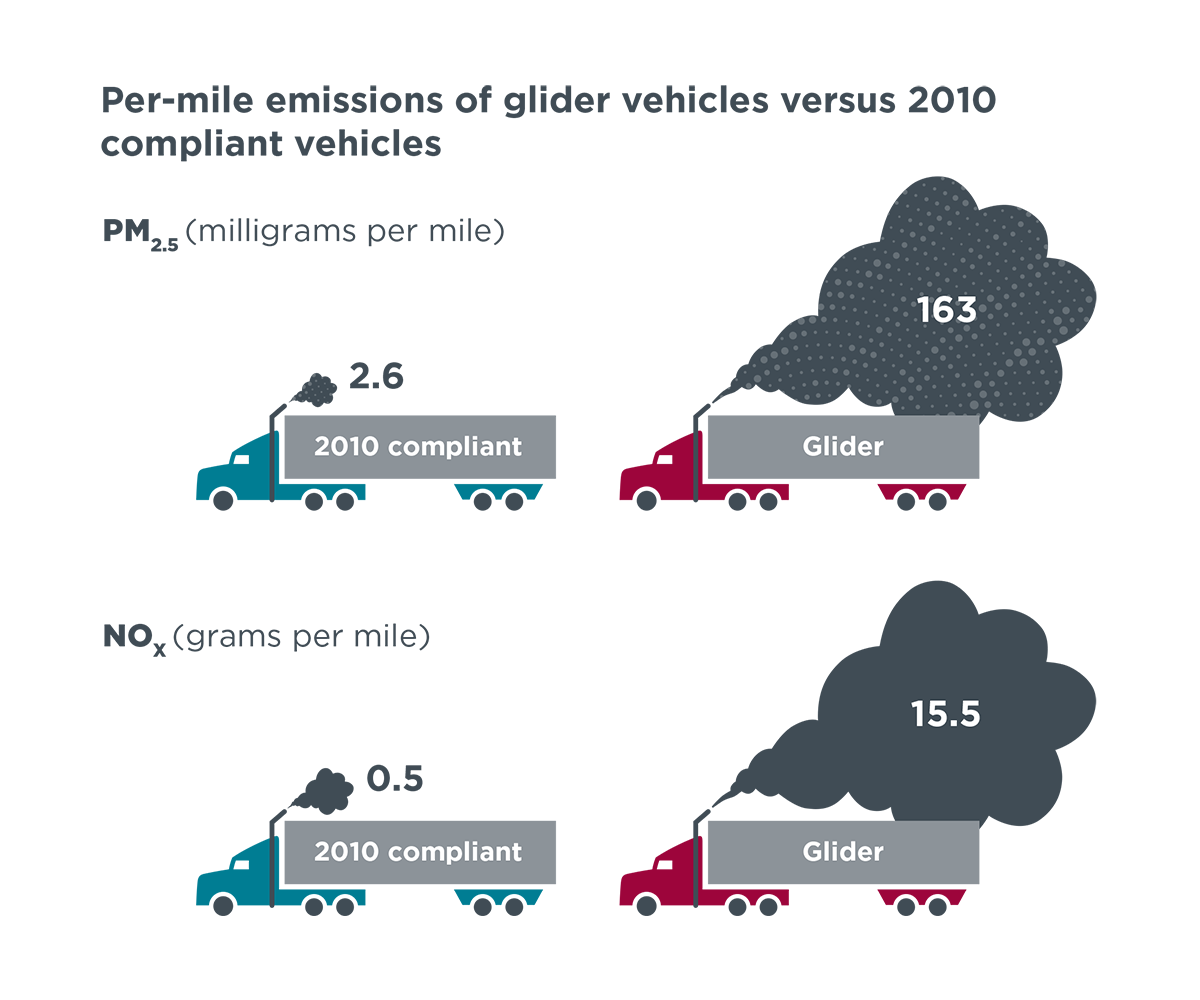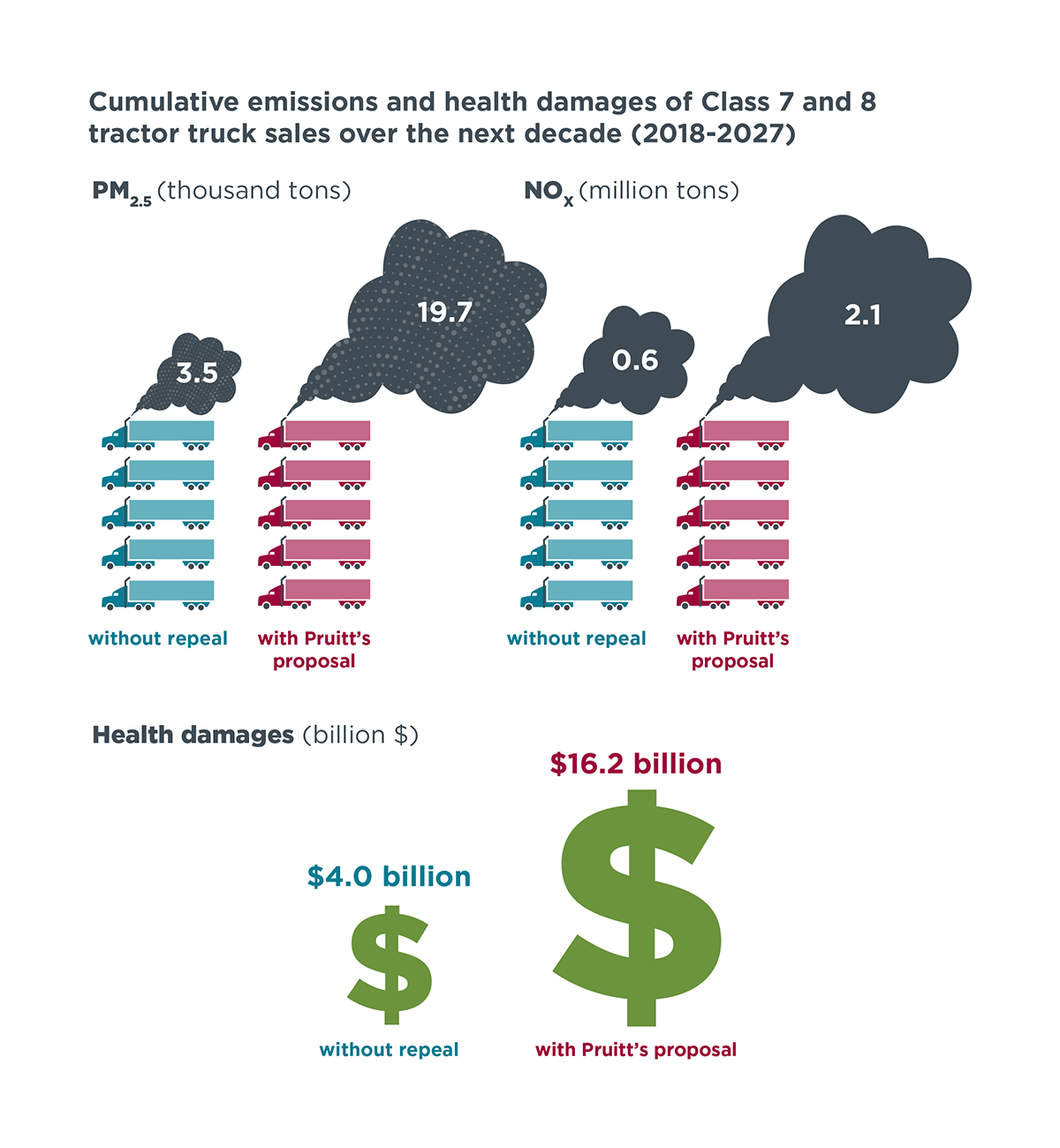Glider industry petition in support of glider trucks debunks itself
Blog
Scott Pruitt’s EPA wants to resurrect the dirty diesel
Can’t get enough of zombie movies? Well, get ready for a real-life version. Scott Pruitt’s EPA is bringing the oldest and dirtiest diesel engines back from the dead—but disguising them in a shiny new host body. How? In the form of the innocuous-sounding glider truck.
From the outside, a glider looks like any other modern Peterbilt, Kenworth, Freightliner, or Western Star semi tractor. But look under the hood and things start to get terrifying. Inside you will find an engine that was thought to be long dead—an engine that emits uncontrolled levels of nitrogen oxides (NOx) and particulate matter (PM).
Make no mistake, the engines inside these glider trucks are literally killers. The American Cancer Society lists diesel exhaust as a Group 1 known carcinogen to humans, alongside things like asbestos and radiation. In addition to lung cancer, long-term exposure to diesel exhaust has been linked to stroke, heart disease, pulmonary disease, chronic respiratory illnesses, asthma, bronchitis, and infections. And these killers always pick off the weakest ones first: children, the elderly, the sick.
The EPA itself has many times acknowledged the harmful effects of diesel exhaust, and has gone to great lengths to tackle it. Thanks to EPA regulations, NOx and PM emissions from modern diesel engines are more than 90% below what they were 15 years ago. In just the past 10 years, EPA’s actions have led to a greater than 50% drop in PM2.5 and NOx emissions from the country’s on-road vehicle fleet. Put that a different way: about a third of the total PM2.5 reduction across all pollution sources since 2007, and more than half of the total NOx reduction, have come from cleaning up heavy truck exhaust. As a result, air quality in the US has improved substantially: average concentrations of PM2.5 and ozone have dropped by 35% and 13% over that same time frame.
Such a record of success might make you think that those old killer diesel engines are a thing of the past. Wrong.
Scott Pruitt’s EPA has proposed to allow the unfettered sale of glider trucks, reopening a loophole that the previous EPA administrator, Gina McCarthy, had sought to close. Sales of glider kits have increased exponentially in recent years because some unscrupulous but savvy entrepreneurs realized that there was a massive gap in the law: while it limited pollution from new engines, it did nothing to regulate emissions from these undead remanufactured engines when they were housed in new truck bodies. Glider trucks are sold at a 25 percent discount compared to trucks with modern engines, a huge incentive to their infiltration of the new vehicle fleet. That discount is ultimately paid for with human lives.
What would the Pruitt EPA’s proposal mean for air quality? We ran the numbers, and the results are scary. According to the EPA’s own testing, a single glider truck emits 30 times the NOx and 60 times the PM of a modern truck. Sales of glider trucks today are around 10,000 per year—5% of the Class 7 and 8 tractor truck market—up an order of magnitude from 10 years ago. If these numbers continue to grow, even at a moderate level, Scott Pruitt’s proposed regulation would expose US citizens to an additional 1.5 million tons of NOx and 16 thousand tons of PM emissions, equivalent to more than 12 billion dollars in health damages over the next decade. To put this into perspective, those additional NOx emissions are 13 times what the impact of the Volkswagen fraud in the United States would have been if all 482,000 VW diesel cars sold with defeat devices before the EPA and CARB put a stop to it were driven until they died of natural causes.
If Pruitt succeeds, the next time you’re driving down the interstate and see what looks like a brand new tractor-trailer, keep an eye out for a plume of black smoke. Lurking beneath the hood could be one of the living dead.
Per-mile emissions of glider vehicles versus 2010 compliant vehicles. Results are derived from chassis dynamometer testing conducted by US EPA’s National Vehicle & Fuel Emissions Laboratory (November 20, 2017). Results reflect a 95% weighting of highway activity (55 and 65 mph cycles) and 5% weighting of transient activity (ARB transient) for a test vehicle with a combined weight of 60,000 pounds (including the tractor, trailer, and payload).
Cumulative emissions and health damages of Class 7 and 8 tractor truck sales over the next decade (2018-2027). Estimates without repeal assume glider vehicle sales without 2010 emissions compliant engines drop to 1,000 units per year from 2018 to 2020 and to zero starting in 2021. Estimates with Pruitt’s proposal assume sales of glider vehicles with pre-2002 engines are permitted to grow from approximately 10,000 units per year in 2015 to 17,400 units per year in 2027 (10.4% of total sales). Annual total sales and vehicle-miles traveled by tractor-trailers are sourced from US EPA’s Motor Vehicle Emission Simulator (MOVES2014). Monetized health damages (in billion 2017 $) are equal to ICCT estimates of direct PM2.5 and NOX emissions from Class 7 and 8 tractor trucks sold in 2018 and later, multiplied by US EPA estimates of damages per ton of direct emissions from on-road mobile sources in 2016. Damages in future years are converted to present value terms using a discount rate of 5% per year.


